Hebei ZhenXing JinYuan Wire Mesh Group specializes in providing high-quality stainless steel grating, designed for durability and functionality in diverse environments. Our products, made from premium-grade stainless steel, offer strength, corrosion resistance, and longevity. With a wide range of designs and specifications, all crafted using advanced technology, we ensure consistent quality and reliability. We work closely with clients to tailor gratings to specific needs, including size, shape, and load capacity. Our gratings are also easy to clean and maintain, making them suitable for various applications.
Welding in Stainless Steel Grating Production
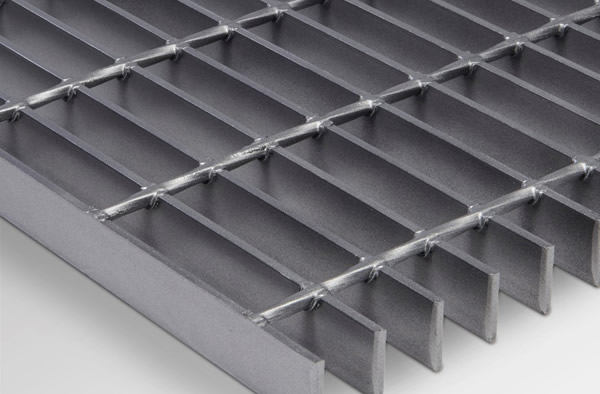
Welding Techniques: Electric resistance and MIG (Metal Inert Gas) welding are commonly used.
- Spot Welding: This method, a form of resistance welding, spot-welds the intersection points of bearing and cross bars. Pressure and electric current are applied to these points, melting and fusing the metal to create a strong bond. This is essential for stability and load-bearing capacity.
- Full Welding: For heavy-duty applications, full welding along intersections is employed for added strength.
Advantages of Welding
- Durability and Strength: Welding creates strong bonds, enhancing the grating’s load-bearing capabilities and durability.
- Corrosion Resistance: Combining proper welding techniques with stainless steel’s inherent resistance to rust ensures long-lasting corrosion resistance.
- Safety: Smooth surfaces from welded joints minimize accident risks.
Considerations in Welding
- Material Properties: Different stainless steel types (e.g., 304, 316) require specific welding methods.
- Weld Quality: High-quality welds are crucial for the grating’s integrity and appearance. Substandard welding can compromise strength and resistance to corrosion.
- Heat Management: Controlled heat input during welding is vital to prevent warping and maintain corrosion resistance.
Post-Welding Treatments
- Cleaning: The grating is cleaned post-welding to eliminate residues and contaminants.
- Passivation: Often, a passivation process follows welding to restore the stainless steel’s corrosion-resistant surface layer.
Press-Locking Process for Stainless Steel Grating
The press-locking process is a key assembly method for stainless steel grating, producing a robust and durable product without welding. Favored for its precision, this method gives the grating a clean, uniform appearance. Ideal for applications where both aesthetics and functionality are crucial, the press-locking process combines aesthetic appeal, strength, and versatility.
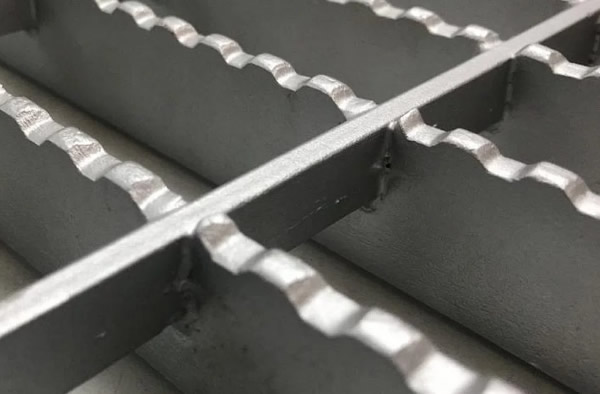
Preparing the Materials
- Bearing Bars: These are the main load-bearing elements of the grating. In the press-locking process, slots are pre-cut into the bearing bars at regular intervals where the cross bars will be inserted.
- Cross Bars: These are the bars that will be inserted into the slots of the bearing bars. They are cut to the required length and prepared for insertion.
Assembly
- Inserting Cross Bars: The cross bars are manually or mechanically inserted into the slots of the bearing bars. This is done with precision to ensure that the bars are perfectly aligned and fit snugly.
- Press-Locking: Once the cross bars are in place, a high-pressure press is used to lock them into position. The press applies a controlled amount of force, deforming the material slightly at the points of contact between the bearing and cross bars. This deformation creates a tight, interlocking connection that holds the bars securely in place.
Finishing the Grating
- Trimming and Finishing: After the press-locking process, the edges of the grating are trimmed and finished to ensure a smooth, clean edge. This step is crucial for both the appearance and safety of the final product.
- Surface Treatment: Although stainless steel has natural corrosion resistance, additional surface treatments such as passivation can be applied to enhance this property and remove any free iron from the surface.
Quality Control
- Inspection: Each piece of grating is thoroughly inspected to ensure that the press-locking process has been executed correctly and that the grating meets all required specifications.
- Load Testing: Depending on the application, load tests may be conducted to ensure the grating can withstand the expected forces and loads.
Advantages of Press-Locking
- Aesthetic Appeal: Press-locked grating often has a more uniform and aesthetically pleasing appearance compared to welded grating.
- Strength and Stability: The interlocking mechanism provides excellent strength and stability, making it suitable for a variety of applications.
- No Welding Required: Eliminating the need for welding means there are no heat-affected zones, which can be beneficial in maintaining the corrosion resistance of stainless steel.
- Flexibility in Design: The process allows for more flexibility in design, as the size and spacing of the slots can be easily adjusted to meet different requirements.
Applications
- Architectural and Decorative Uses: Due to its neat appearance, press-locked grating is often used in architectural and decorative applications.
- Industrial and Commercial Applications: It is also suitable for various industrial and commercial applications, especially where aesthetics are important alongside functionality.
General Specifications for Stainless Steel Grating
General specifications for stainless steel grating can vary based on the Please note that these are general guidelines, and specific applications may require different specifications.
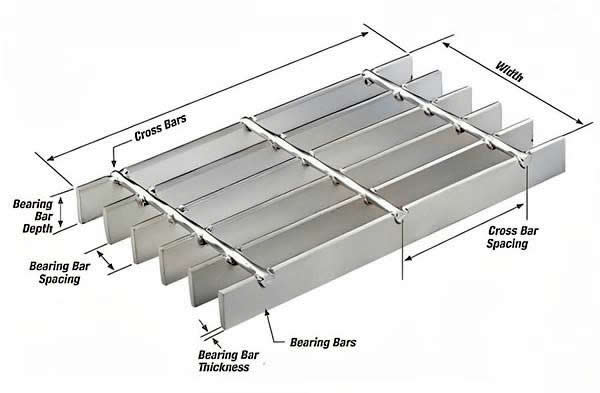
Bearing Bar Dimensions
- Width (Thickness): This is the horizontal dimension across the top of the bearing bar. Typical widths for stainless steel grating bearing bars are: 3 mm, 4 mm,5 mm,6 mm,8 mm
- Depth (Height): This is the vertical dimension of the bearing bar. Common depths for stainless steel grating bearing bars include:
20 mm, 25 mm,30 mm, 40 mm, 50 mm
Bearing Bar Spacing
- Center to Center Spacing: 30mm to 50mm (commonly 30mm for heavy-duty and 40mm for light-duty applications)
Cross Bar Dimensions
- Diameter: 6mm to 10mm (common sizes: 6mm, 8mm)
- Spacing: Typically 50mm to 100mm
Thickness
- Overall Thickness of Grating: refers to the total height of the grating panel, measured from the bottom of the bearing bars to the top surface. This measurement is crucial for various applications as it affects the grating’s load-bearing capacity, compatibility with its intended installation location, and overall durability.This can vary based on the depth of the bearing bars and the method of assembly (welded, press-locked, etc.). Generally, it can range from 20mm to 75mm.
Load Capacity Range for Stainless Steel Grating
The load capacity of stainless steel grating depends on various factors, including the dimensions of the bearing bars, the spacing of the bars, the material’s thickness, and the overall design of the grating. Because of these variables, load capacity can vary significantly.
- Light-Duty Applications: For grating used in pedestrian areas or for light equipment, the load capacity can range from 250 kg/m² to 750 kg/m².
- Medium-Duty Applications: Common in commercial settings or for light vehicular traffic, load capacities typically range from 750 kg/m² to 1250 kg/m².
- Heavy-Duty Applications: For industrial areas or heavy vehicular traffic, load capacities can range from 1250 kg/m² to 2500 kg/m² or more.
Factors Affecting Load Capacity
- Bearing Bar Size and Thickness: Thicker and deeper bearing bars typically increase load capacity.
- Bar Spacing: Closer bar spacing can support heavier loads.
- Material Grade: Different grades of stainless steel have varying strength characteristics.
- Type of Load: Static loads (constant) and dynamic loads (moving) affect the grating differently.
Certain dimensions and specifications can be tailored to specific project requirements. For precise, application-specific measurements, consult with our team.
See pictures for examples
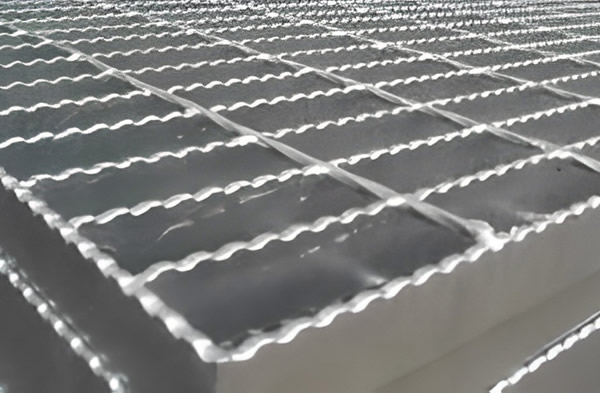
Stainless Steel Walkway Grating: Designed for Pedestrian Safety in Industrial and Public Spaces
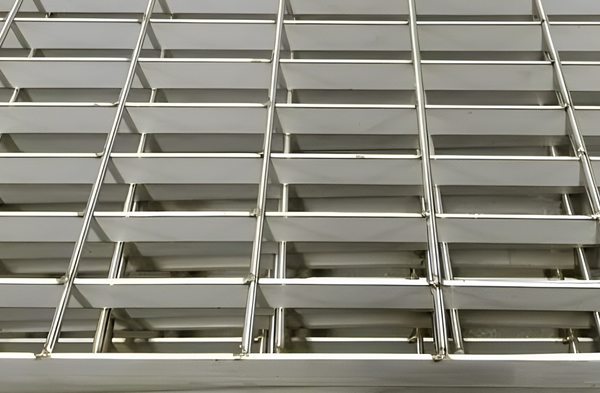
Architectural Stainless Steel Grating: Blending Style and Function in Building Design
Product aliases and Applications
- Stainless Bar Grating: Known as Stainless Bar Grating, this type emphasizes its bar structure, offering high strength and durability. Ideal for heavy-load applications, it combines the robustness of stainless steel with a design that ensures stability and safety, suitable for industrial and architectural uses.
- Stainless Mesh Grating: Referred to as Stainless Mesh Grating, this type focuses on its mesh-like pattern, providing excellent ventilation and a modern aesthetic. It’s ideal for architectural designs, offering both functional and decorative benefits in a variety of settings.
- Stainless Steel Walkway Grating: Known as Stainless Steel Walkway Grating, this type is specifically designed for pedestrian areas. Its non-slip surface and robust construction make it ideal for walkways, staircases, and platforms, ensuring safety in both industrial and public spaces.
- Industrial Stainless Grating: Industrial Stainless Grating is tailored for demanding industrial environments. It withstands heavy loads and extreme conditions, making it a reliable choice for manufacturing plants, refineries, and other industrial settings where strength and corrosion resistance are paramount.
- Stainless Platform Grating: Stainless Platform Grating, designed for platform applications, combines the inherent strength of stainless steel with safety and stability. This makes it suitable for a variety of elevated structures, from industrial platforms to observation decks.
- Hygienic Stainless Grating: Hygienic Stainless Grating, with its easy-to-clean surface and non-corrosive properties, is ideal for food processing, pharmaceutical, and medical environments. It meets stringent hygiene standards while providing a durable and safe flooring solution.
Each variation of Stainless Steel Grating serves a specific purpose: Walkway Grating for pedestrian safety, Industrial Grating for heavy-duty environments, Platform Grating for elevated areas, and Hygienic Grating for cleanroom conditions, highlighting the material’s versatility and functionality.
Commitment to Customer Satisfaction
At Hebei ZhenXing JinYuan Wire Mesh Group, customer satisfaction is at the forefront of our business. We are dedicated to delivering products that not only meet but exceed expectations. Our team offers comprehensive support, from initial consultation to after-sales service, ensuring a seamless experience for our clients. We sincerely welcome calls, letters, or visits to our factory.

